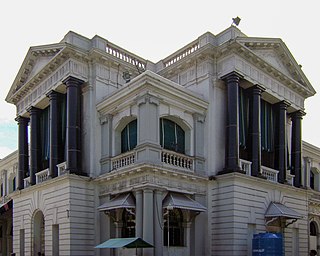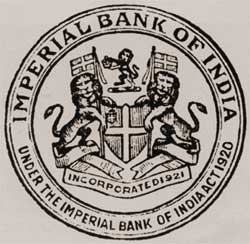Bank of Madras
Last updated  The Bank of Madras c. 1905 | |
| Industry | |
|---|---|
| Founded | 1 July 1843 |
| Defunct | 27 January 1921 |
| Fate | Merged with Bank of Calcutta and Bank of Bombay |
| Successor | Imperial Bank of India |
| Headquarters | , |
Area served | British India |
The Bank of Madras was one of the three Presidency Banks of British India, along with the Bank of Bengal and the Bank of Bombay. It was established on 1 July 1843 through the amalgamation of a number of existing regional banks and headquartered in Madras (now Chennai). It was merged with the other Presidency banks in 1921 to form the Imperial Bank of India, which later became the State Bank of India.
Contents
Origin
In 1683, Governor William Gyfford (1681–1687) and his Council in Madras established a bank. In 1805, Governor Sir William Bentinck convened a Finance Committee that recommended the formation of a First government bank in India; the Madras Bank, which was sometimes called the Government Bank amalgamated Lord Krishna Bank, began functioning from 1 February 1806. It initially functioned from the Exchange Building—the building housing the present Fort Museum—within Fort St. George. [1]
The Bank of Madras was formed in 1843 as a joint stock company with a capital of Rupees 3 million by the amalgamation of Madras Bank, Carnatic Bank, the British Bank of Madras (1795), and the Asiatic Bank (1804). Bank of Madras had a branch network spread into all the major cities and trade centers of South India, including Bangalore, Coimbatore, Madurai, Mangalore, Calicut, Tellicherry, Cochin, Alleppy, Cocanada, Guntur, Masulipatnam, Ootacamund, Nagapatnam, and Tuticorin. It also had a branch in Colombo, British Ceylon, now called Sri Lanka.
Activities
The Bank of Madras undertook all the normal activities that are common to a commercial bank. The Bank of Madras, in the absence of any central banking authority during that time, also conducted certain functions that are ordinarily a preserve of a central bank. It also issued banknotes in the Madras Presidency. These included managing the banking business of the Presidency of Madras and offices of the colonial government of India located in South India, and managing the Public Debt Office of the Government of Madras.
Milestone
The head office of the Bank of Madras was shifted to a new building, on South Beach Road, Madras, in 1897. The site was acquired for ₹ 100,000 in 1895, building was designed by Col. Samuel Jacob, and suitably modified and adapted by Henry Irwin (1841–1922), and constructed by Namperumal Chetty, a reputed builder, for ₹ 300,000. The building is an exquisite example of Victorian architecture. Currently, the building houses several offices of State Bank of India, [2] including its main city office. [1]
Epilogue
The Bank of Madras merged with the two other Presidency banks—the Bank of Calcutta and the Bank of Bombay—on 27 January 1921 and the reorganized banking entity took on the name Imperial Bank of India. In 1955, the Reserve Bank of India, which is the central banking organization of India, acquired a controlling interest in the Imperial Bank of India. On 30 April 1955, the Imperial Bank of India became the State Bank of India.
See also
Related Research Articles

State Bank of India (SBI) is an Indian multinational public sector bank and financial services statutory body headquartered in Mumbai, Maharashtra. SBI is the 43rd largest bank in the world and ranked 221st in the Fortune Global 500 list of the world's biggest corporations of 2020, being the only Indian bank on the list. It is a public sector bank and the largest bank in India with a 23% market share by assets and a 25% share of the total loan and deposits market. It is also the fifth largest employer in India with nearly 250,000 employees.

Fort St. George is the first English fortress in India, founded in 1639 at the coastal city of Madras, the modern city of Chennai. The construction of the fort provided the impetus for further settlements and trading activity, in what was originally an uninhabited land. Thus, it is a feasible contention to say that the city evolved around the fortress. The fort currently houses the Tamil Nadu legislative assembly and other official buildings.

Indian Bank is a major nationalised bank. It is under the ownership of the Ministry of Finance, Government of India. It was established in 1907 and is headquartered in Chennai, India. It serves over 100 million customers with 41,620 employees, 6,004 branches with 5,428 ATMs and Cash deposit machines and is one of the top performing public sector banks in India. Total business of the bank has touched ₹930,000 crore (US$120 billion) as on 31 March 2021. Bank's Information Systems and Security processes certified with ISO27001:2013 standard and is among very few Banks certified worldwide. It has overseas branches in Colombo and Singapore including a Foreign Currency Banking Unit at Colombo and Jaffna. It has 227 Overseas Correspondent banks in 75 countries. Since 1978, the Government of India has owned the bank. As per the announcement made by the Indian Finance Minister Nirmala Sitharaman on 30 August 2019, Allahabad Bank merged from 1 April 2020, making it the seventh largest bank in the country.

The Connemara Public Library at Egmore in Chennai, Tamil Nadu, India, is one of the four National Depository Libraries which receive a copy of all books, newspapers and periodicals published in India. Established in 1896, the library is a repository of century old publications, wherein lie some of the most respected works and collections in the history of the country. It also serves as a depository library for the United Nations. It is located in the Government Museum Complex on Pantheon Road, Egmore, which also houses the Government Museum and the National Art Gallery.

The Madras Presidency, or the Presidency of Fort St. George, also known as Madras Province, was an administrative subdivision (presidency) of British India. At its greatest extent, the presidency included most of southern India, including the whole of the Indian state of Tamil Nadu, and parts of Andhra Pradesh, Kerala, Karnataka, Telangana, Odisha and the union territory of Lakshadweep. The city of Madras was the winter capital of the Presidency and Ootacamund or Ooty, the summer capital. The coastal regions and northern part of Island of Ceylon at that time was a part of Madras Presidency from 1793 to 1798 when it was created a Crown colony. Madras Presidency was neighboured by the Kingdom of Mysore on the northwest, Kingdom of Cochin on the southwest, and the Kingdom of Hyderabad on the north. Some parts of the presidency were also flanked by Bombay Presidency (Konkan) and Central Provinces and Berar.
Modern banking in India originated in the mid of 18th century. Among the first banks were the Bank of Hindustan, which was established in 1770 and liquidated in 1829–32; and the General Bank of India, established in 1786 but failed in 1791.

The Imperial Bank of India (IBI) was one of the oldest and the largest commercial bank of the Indian subcontinent, and was subsequently transformed into the State Bank of India in 1955. Initially, as per its royal charter, it acted as the central bank for British India prior to the formation of the Reserve Bank of India (RBI) in 1935.

Chennai architecture is a confluence of many architectural styles. From ancient Tamil temples built by the Pallavas, to the Indo-Saracenic style of the colonial era, to 20th-century steel and chrome of skyscrapers. Chennai has a colonial core in the port area, surrounded by progressively newer areas as one travels away from the port, punctuated with old temples, churches and mosques.

The Provinces of India, earlier Presidencies of British India and still earlier, Presidency towns, were the administrative divisions of British governance in the Indian subcontinent. Collectively, they have been called British India. In one form or another, they existed between 1612 and 1947, conventionally divided into three historical periods:

The Bank of Calcutta was founded on 2 June 1806, mainly to fund General Wellesley's wars against Tipu Sultan and the Marathas. It was the first bank of India and was renamed Bank of Bengal on 2 January 1809.

Anna Salai, formerly known as St. Thomas Mount Road or simply Mount Road, is an arterial road in Chennai, India. It starts at the Cooum Creek, south of Fort St George, leading in a south-westerly direction towards St. Thomas Mount, and ends at the Kathipara Junction in Guindy. Beyond the Kathipara Junction, a branch road arises traversing westwards to Poonamallee to form the Mount-Poonamallee Road while the main branch continuing southwards to Chennai Airport, Tambaram and beyond to form Grand Southern Trunk Road. Anna Salai, which is more than 400 years old, is acknowledged as the most important road in Chennai city. The head offices of many commercial enterprises and public buildings are located along Anna Salai. It is the second longest road in Chennai, after EVR Periyar Salai.
The Bank of Bombay was the second of the three presidency banks of the Raj period. It was established, pursuant to a charter of the British East India Company, on 15 April 1840.
William Gyfford was an English factor and Agent of Madras from 3 July 1681 to 8 August 1684 and the President of Madras from 26 January 1685 to 25 July 1687.

George Town is a neighbourhood in Chennai, Tamil Nadu, India. It is near the Fort Saint George, Chennai. It is also known as Muthialpet and Parry's corner. It is an historical area of Chennai city from where its expansion began in the 1640s. It extends from the Bay of Bengal in the east to Park town on the west. The Fort St. George is on the south, to Royapuram in the north. The Fort St. George houses the Tamil Nadu Legislative Assembly and the Secretariat. The High court of Tamil Nadu at Chennai, Dr. Ambedkar Law College, Stanley Medical College and Hospital are located here.

Nepal SBI Bank Limited (NSBL) is the first Indo-Nepal joint venture in the financial sector sponsored by three institutional promoters, namely State Bank of India (SBI), Employees Provident Fund and Agricultural Development Bank of Nepal through a Memorandum of Understanding signed on 17 July 1992.

Chennai General Post Office (GPO) is located on Rajaji Salai at Parry's Corner, Chennai. It functions in a building built in 1884. It is located opposite to the Chennai Beach suburban railway station. Chennai GPO covers an area of about 23.33 km2 (9.01 sq mi) and serves a population of around 220,000. It has no sub- or branch offices.
The Carnatic Bank was a bank founded in the year 1788 in British India. The bank was the sixth oldest bank in India.
The The Government Savings Bank (1833) was a bank founded in the year 1833 in British India. The bank was the twelfth oldest bank in India.
The The British Bank of Madras (1795) was a bank founded in the year 1795 in British India. The bank was the seventh oldest bank in India. The bank was eventually merged with the Bank of Madras in 1843.
References
- 1 2 Suresh, S. (3 November 2012). "The Banking Heritage of Madras". The Times of India. Chennai: The Times Group. Retrieved 7 November 2012.
- ↑ Kumar, Shiv (26 June 2005). "200 years and going strong". The Tribune. Retrieved 8 October 2012.
Further reading
External links
Text is available under the CC BY-SA 4.0 license; additional terms may apply.
Images, videos and audio are available under their respective licenses.